Technologies
Apple Watch Series 9 Review: New Tricks Make for a Minor Upgrade
With Double Tap and a faster Siri, the Apple Watch Series 9 is slightly easier to use. But it otherwise has a lot in common with the Series 8.
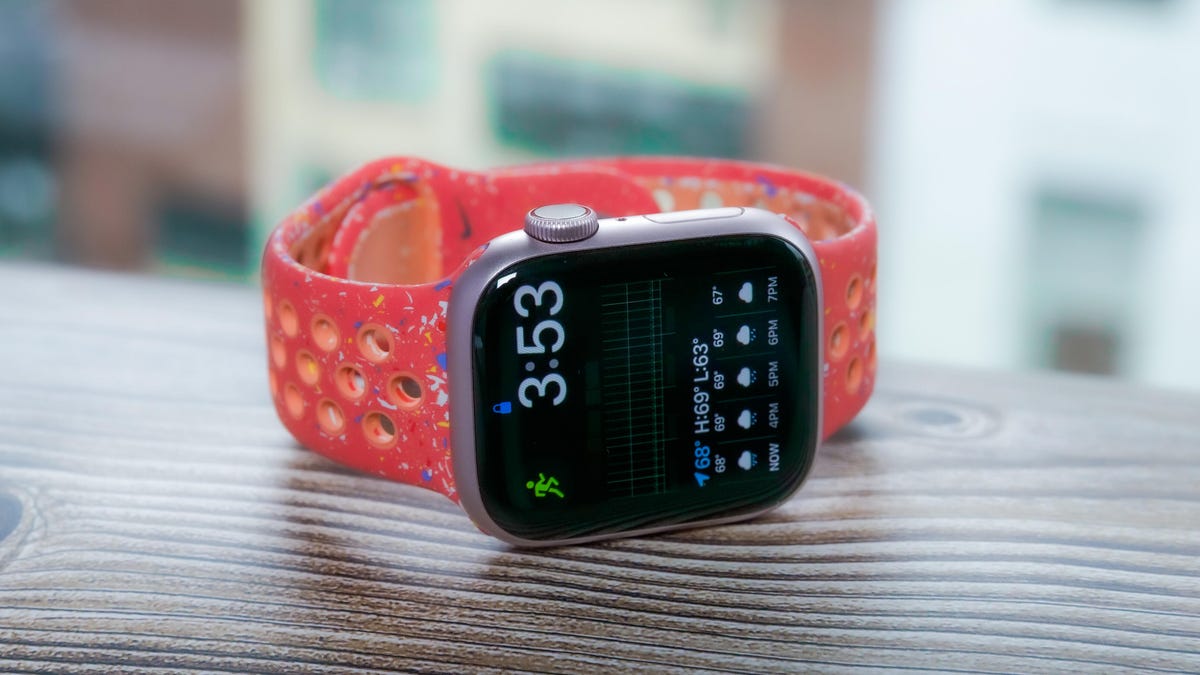
When it comes to the new Apple Watch Series 9, which starts at $399 (£399, AU$649) and is available now alongside the Apple Watch Ultra 2, it’s what’s on the inside that counts. That’s my biggest takeaway after spending a few days with the Series 9, which has an upgraded chip that powers faster Siri performance and new gesture controls called Double Tap.
It’s these additions that separate the Series 9 from last year’s Series 8, and they make the Apple Watch more convenient to use. But they’re not monumental enough to convince recent buyers to upgrade.
My time with the Series 9 so far suggests that new features like Double Tap may not show their usefulness right away. However, they could become helpful in the long run.
Double Tap takes some getting used to, and it’s not compelling enough on its own to justify buying the Series 9. But I’d be lying if I said I didn’t find myself using it to dismiss a notification and easily navigate back to my watch face here and there. (The version of Double Tap I tested was a preview, which I accessed on a separate review unit running an early software build of the feature.)
Siri’s most appealing update, the ability to answer health-related questions now that it can process data locally instead of in the cloud, isn’t coming until later this year. Yet if it works as promised, it could make the Series 9 a much more useful health tracker.
The Series 9 doesn’t have everything on my wish list. For example, I was hoping for longer battery life and the Apple Watch Ultra’s Action button. But as is the case with the iPhone 15, it will be a solid upgrade for those with an older model. That’s especially true for frequent Siri users and those who primarily use their Apple Watch for exercise and wellness tracking.
Apple Watch Series 9’s new Double Tap gesture
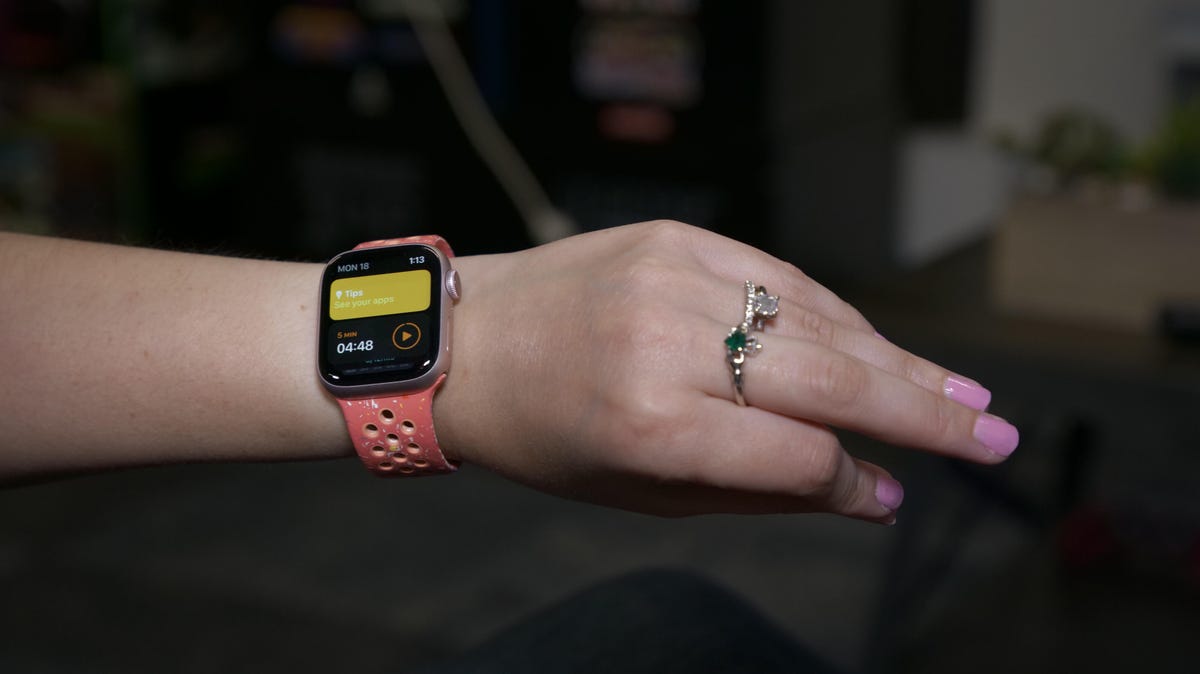
Apple rarely adds new gestures to the Apple Watch, so I was eager to try Double Tap. Just as the name implies, you trigger this feature by tapping your index finger and thumb together twice. Doing so allows you to dismiss a notification, pause your timer or access widgets from the watch face, among other actions. It’s programmed to perform whatever the primary action in a notification is, whether that be casting aside your standard reminder or replying to a text message.
The Apple Watch already supported a similar gesture through its AssistiveTouch accessibility mode. But Double Tap is baked into the Series 9’s user interface across the board, and its chip enables the watch to support this feature all day without impacting battery life. The pinching feature that’s included as part of the watch’s accessibility options, meanwhile, is meant to be customized based on a person’s needs.
Double Tap has a bit of a learning curve, but that could be because I’m using an early version of it. I most frequently use Double Tap to dismiss notifications, stop timers and send text messages hands-free. This was particularly useful while brushing my teeth before bed, since I like to check the time and my exercise progress before hitting the sack. When a notification was blocking my watch face, I pinched my fingers together to dismiss it without having to put down my toothbrush.
It’s a simple use case, but one that highlights the promise behind Double Tap. Being able to dictate a response to a text message without touching the watch could also be useful in situations when my hands are full, such as when I’m cleaning, cooking or even gripping the subway pole during my commute to work.
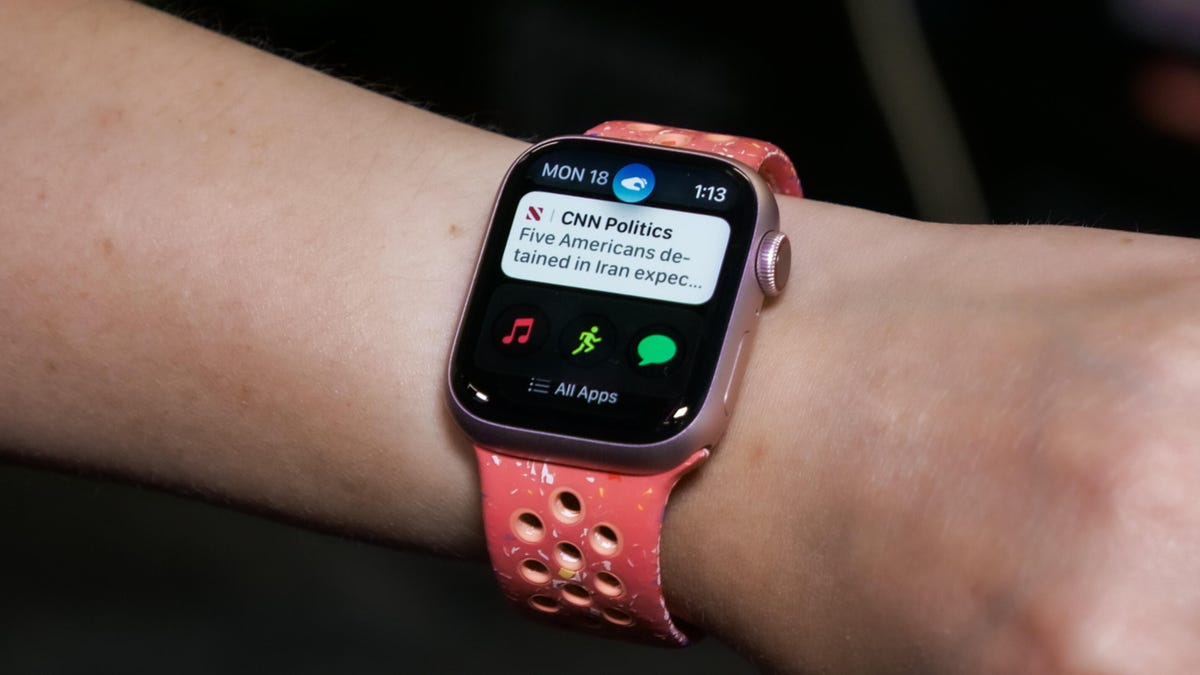
My biggest issue with Double Tap, however, is that it just doesn’t feel intuitive yet. We’ve been conditioned to tap, swipe and speak to our devices over the last two decades. Even though Double Tap came in handy during that one instance while I was brushing my teeth, my instinct usually tells me to tap my watch’s screen. It’s going to take time to break that habit.
Double tapping can also look awkward to those who aren’t familiar with it. When I tested the Apple Watch Series 9 over the weekend, a friend began giving me strange looks when I started pinching the air with my fingers.
Double Tap doesn’t feel as game-changing as other user experience-related updates the Apple Watch has received over the years, like the Series 5’s always-on display. But who knows — maybe it’ll start to feel natural. After all, everyone thought AirPods looked goofy at first, but now they’re everywhere. Double Tap doesn’t feel like a reason to upgrade, but we’ll know more when the feature fully launches.
Siri gets a speed boost on the Series 9
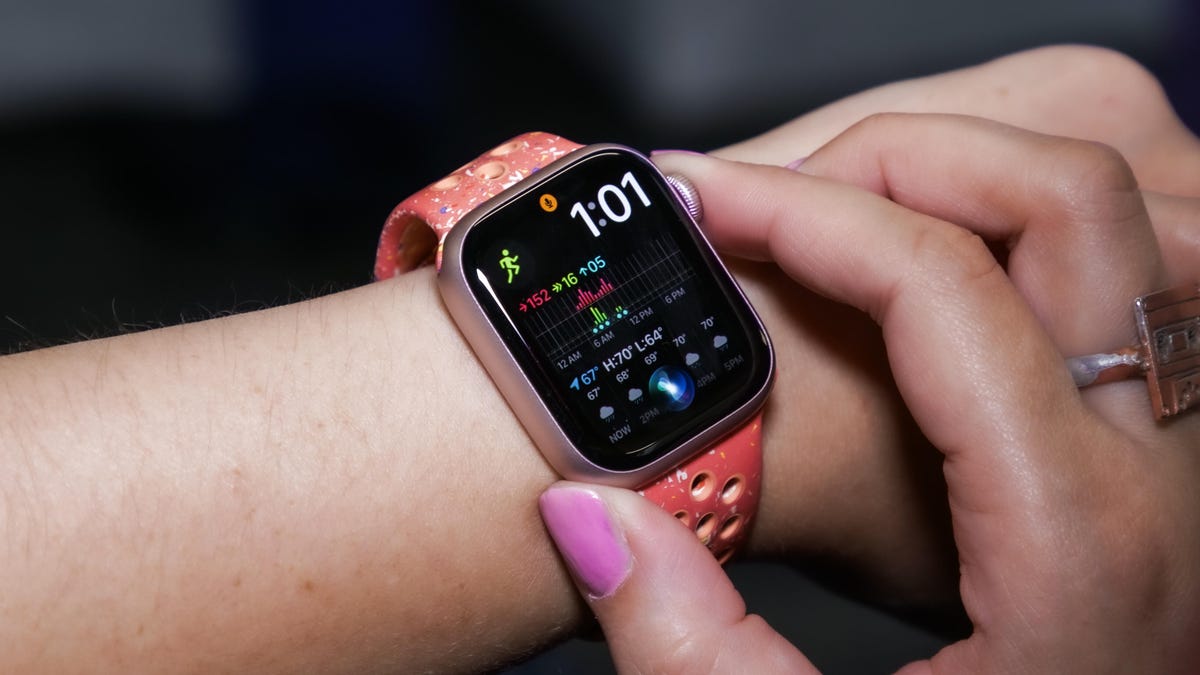
Another benefit from the Series 9’s new S9 processor is a faster Siri experience. Siri can now answer requests slightly faster for two reasons. First, certain queries that Siri doesn’t need to rely on the internet to answer, like setting alarms or timers, now happen on the watch. Dictation is also supposed to be up to 25 percent more accurate, which should mean Siri understands you correctly the first time.
Coming from the Series 8, I noticed a difference. I use Siri daily for setting alarms and timers, especially when I’m stretching before a workout. I often repeat myself when using my Series 8 or the Series 6 I bought roughly three years ago. That hasn’t happened as much on the Series 9 so far.
I also timed how long it took for Siri to respond to certain questions on the Series 9 compared to the Series 8. For this test, I only asked questions that Siri could answer without plucking an answer from the web. Siri was faster on the Series 9 in almost every scenario, as you can see in the table below.
Series 9 vs. Series 8: Siri response times
| Series 9 (in seconds) | Series 8 (in seconds) | |
|---|---|---|
| «Set a timer for 5 minutes» | 1.73 | 2.52 |
| «Cancel my timer» | 1.66 | 1.74 |
| «Set an alarm for 9 a.m.» | 1.81 | 1.93 |
| «Start an outdoor walk» | 3.39 | 3.32 |
| «Stop my workout» | 2.33 | 3.06 |
| «Cancel my alarm» | 1.94 | 2.2 |
Siri will soon be able to answer health-related queries, which should make it easier to quickly parse all the activity and health metrics your watch gathers throughout the day and night. But it won’t be launching until later this year.
I’ve been waiting for a feature like this because finding what I’m looking for in Apple’s Health app isn’t always intuitive. Manually logging activity data and finding specific metrics, like exercise minutes for the past week, can take a couple of taps. Using Siri should hopefully make queries like these much faster and more convenient.
It’s also nice to see Siri playing a larger role on the Apple Watch. Smartwatches aren’t ideal for long touchscreen interactions given their small size, so they present an opportunity for voice assistants like Siri to shine.
Apple Watch Series 9 is better at finding your iPhone
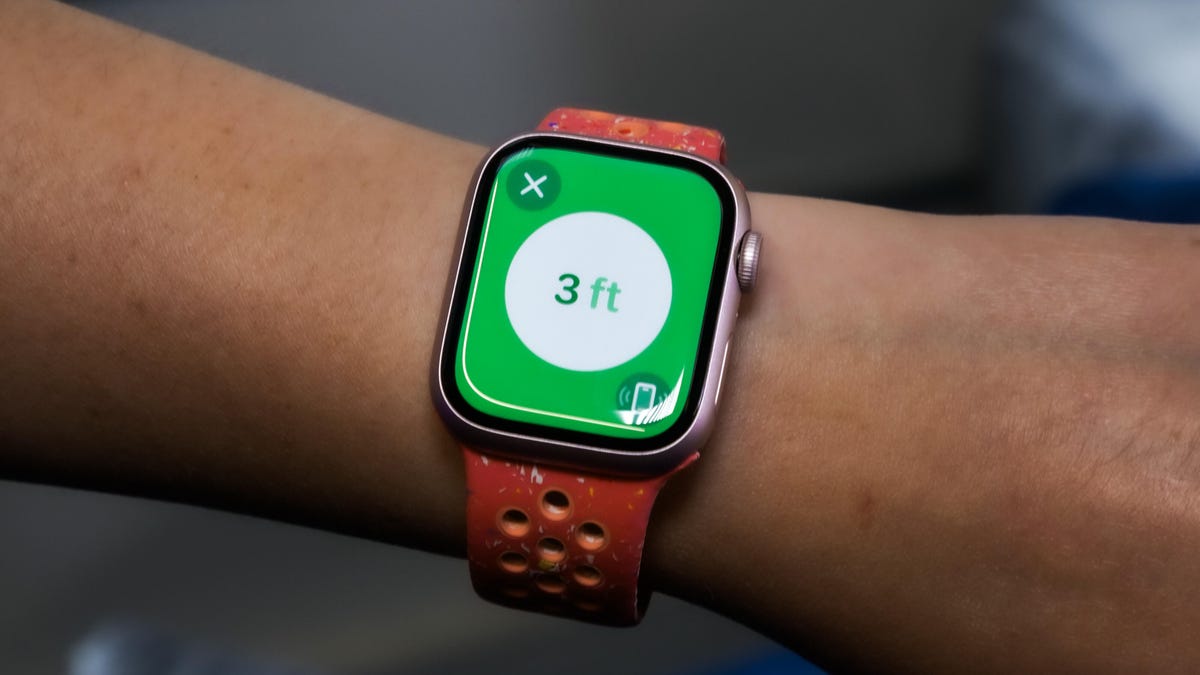
If you’re anything like me, the Apple Watch has been a godsend for tracking down your misplaced iPhone when it slips between the couch cushions. Apple made the watch an even more useful iPhone locator, thanks to the second-generation ultra-wideband chip inside. Not only can you ping your iPhone, but the Series 9 will show an estimate of how far away you are from your phone, along with a nudge in the right direction.
The catch, however, is that this feature only works if you have an iPhone 15 or iPhone 15 Pro, since those are the only Apple phones to also have the new ultra-wideband chip. That means unless you plan to buy a new iPhone along with your Apple Watch, you won’t be able to use it.
To put the Apple Watch’s new Precision Finding feature to the test, I had a friend of mine hide my iPhone 15 in my apartment while I waited in another room. He chose a difficult hiding spot; tucked underneath my living room carpet, a place where my phone is never likely to end up, even by accident. But the Apple Watch pointed me to the exact corner where my phone was hidden almost immediately, and I was able to track it down in less than five minutes.
To be fair, the audible chime that my iPhone emitted when being pinged by my Apple Watch also played a big role in helping me find it. That feature is already available on existing Apple Watches and iPhones. But being able to see how many feet away I was from my phone added an extra layer of confidence that I was looking in the right direction. This could be helpful if I lost my phone in a noisy environment like a restaurant.
The new chip also brings tighter HomePod integration, allowing you to see media suggestions at the top of your watch’s widget stack when you’re within 4 meters of the device. While these new features are limited to those who own the iPhone 15 or a HomePod, I’m glad to see Apple finding new ways to put ultra-wideband to use. It’s something I’ve been hoping to see in future Apple Watches, as I wrote back in 2022.
Same health and wellness as the Series 8
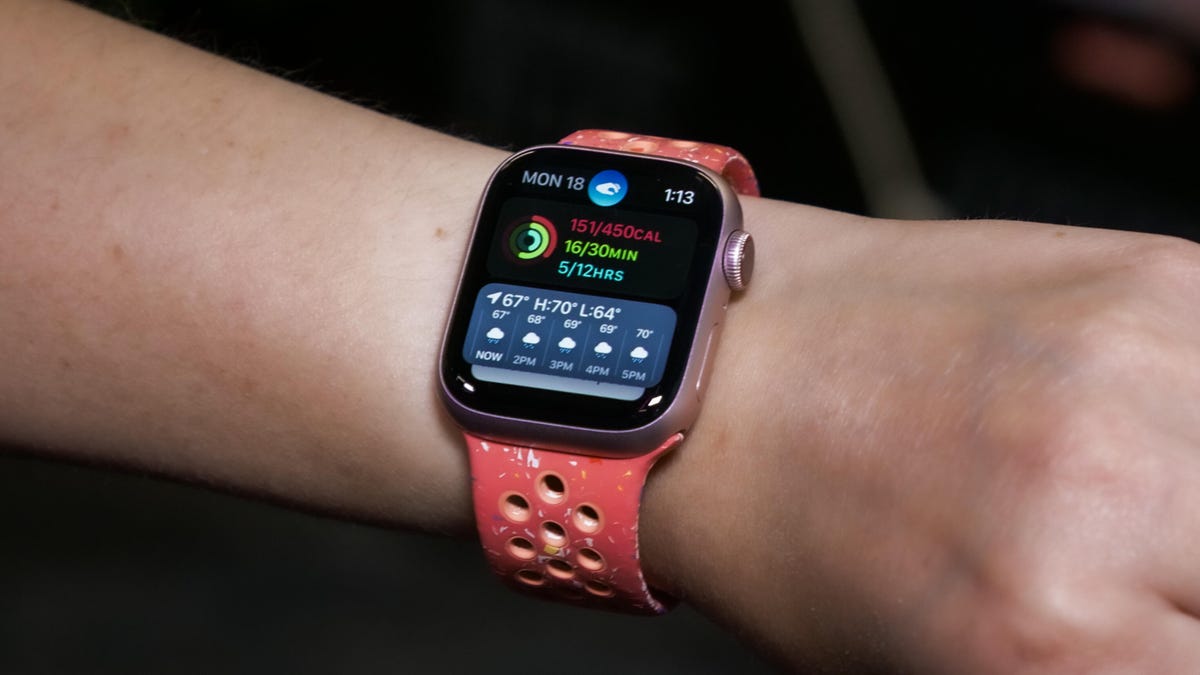
The Series 9 inherits the same health and safety features as the Series 8. That includes the ability to take an ECG, temperature sensing, blood-oxygen detection, high and low heart-rate notifications, irregular heart rhythm notifications, sleep stage tracking, fall detection and crash detection. It’s also rated for the same degree of dust and water resistance as last year’s Series 8.
The Apple Watch’s broad selection of health metrics is exactly what you might expect of a smartwatch at this price, and it’s likely more data than most people need. But I’m still waiting for more features aimed at rest and recovery, a key area where other wellness and sports devices from brands like Oura, Fitbit, Garmin and Whoop excel over Apple. These gadgets can analyze bodily markers and activity trends to assess how well rested you are, which can be easier to decide whether it’s time for a workout or a rest day. However, Apple doesn’t charge a subscription fee to access all health insights, unlike Fitbit, Oura and Whoop, which require memberships to get the full experience.
No Action button and the same battery life as Series 8
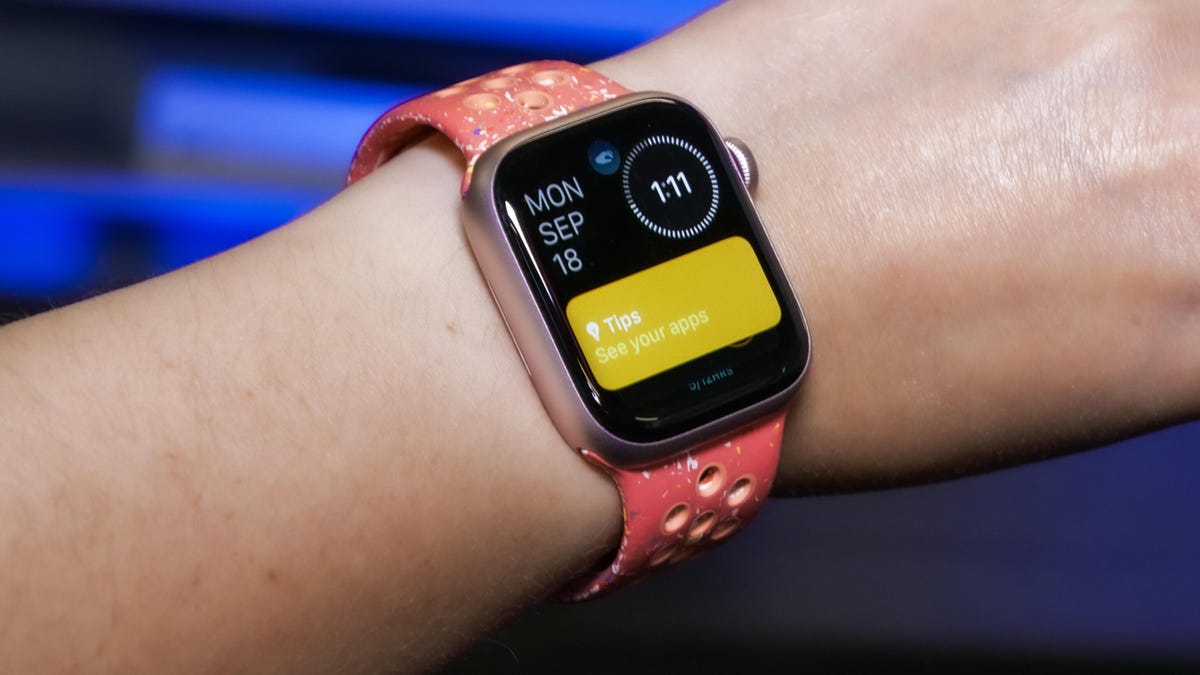
The Series 9’s theme is seemingly focused on convenience rather than new health features. That’s why I was hoping the Series 9 would gain the Apple Watch Ultra’s Action button, a programmable key that lets you perform tasks like starting a workout or a stopwatch with just a tap.
While keeping certain features exclusive to the Ultra line is understandable given its higher price, the Action button feels like it should be part of the broader Apple Watch experience. The Ultra already has plenty of other features to distinguish it from the Series 9 and SE, including a bigger and brighter screen, longer battery life, a more durable design and a depth gauge, among other extras. The Action button would have fit nicely with the Series 9’s other upgrades aimed at helping you navigate the watch more easily.
The Series 9 has an always-on display, just like every flagship watch model since the Series 5, which is a key feature that separates it from the less expensive $249 Apple Watch SE. While the overall design is the same, Apple reduced its carbon footprint to make the Series 9 paired with a Sport Loop band the company’s first carbon neutral product.
It’s also rated for the same 18-hour battery life as the Series 8, which means it should last for one to 1.5 days on a single charge, depending on how you’re using it. On one hand, that’s impressive considering the Series 9 has a brighter screen and a more powerful processor.
But I wouldn’t mind sacrificing some of these new features, like a brighter screen or faster Siri, if it meant having longer battery life. I often find myself choosing between wearing my Apple Watch to sleep or leaving it on the charger overnight so that it’s ready to log my morning walk and afternoon workout. Having a battery that lasts for more than a day and a half means I wouldn’t have to make that decision.
Since I’ve been switching between my main Series 9 review unit and a separate unit with an early version of Double Tap, I haven’t been able to get a solid sense of the Apple Watch’s battery life. But I’ll update this review accordingly with more details.
Apple Watch Series 9: Final thoughts
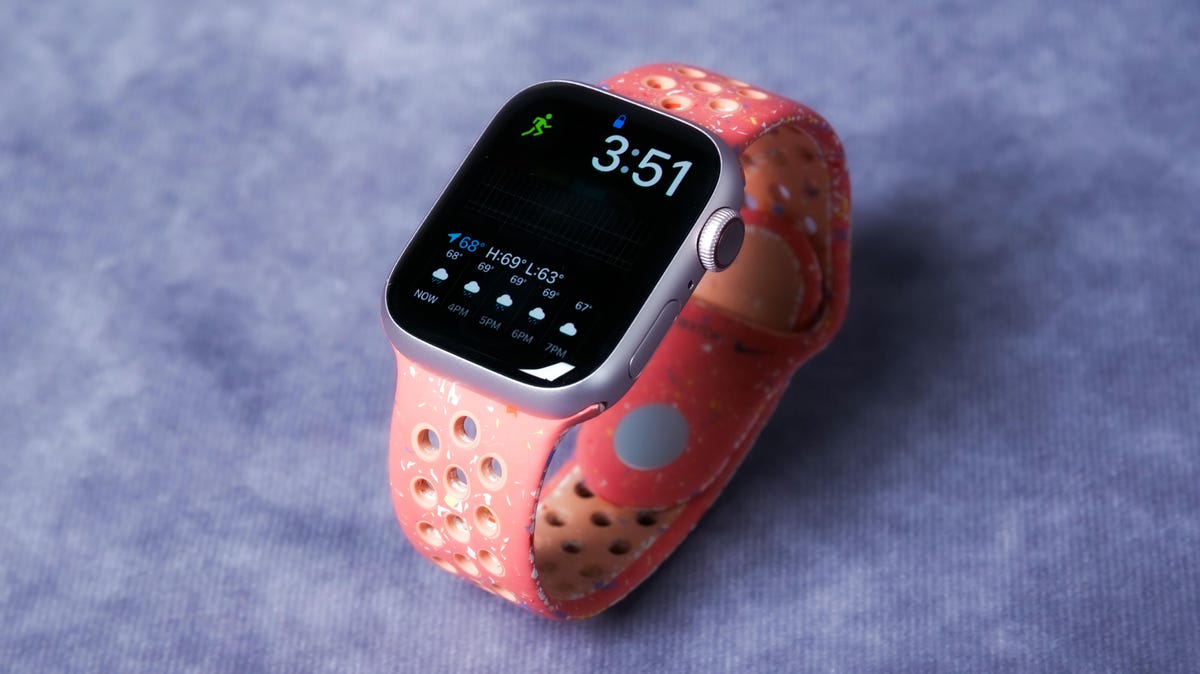
The Series 9 feels like a minor upgrade over the Series 8. New features like Precision Finding and faster Siri performance make the Series 9 a better smartphone companion. But it’s not worth it unless you’re a first-time buyer or have the Series 6 or earlier.
Coming from an older watch like the Series 6, you’ll have plenty to gain. In addition to what’s new on this year’s model, you benefit from a larger screen with a keyboard, a temperature sensor and noticeably faster performance compared to a 3-year-old watch. If you have an Apple Watch SE and are craving more health metrics, the Series 9 is also a worthwhile upgrade.
Like many recent Apple Watch updates, such as the Series 8’s temperature sensor, there’s potential for the Series 9’s new features to evolve and become more helpful over time. It signals a promising direction for the Apple Watch, aligning with the tick-tock pattern Apple has seemingly followed over the last several years. Apple typically alternates between bringing new health sensors to the watch and launching updates related to convenience and the general user experience. This year happens to be the latter.
But right now, the Series 9 feels like a refreshed version of the Series 8 rather than an entirely new generation.
Technologies
Today’s NYT Mini Crossword Answers for Monday, Dec. 1
Here are the answers for The New York Times Mini Crossword for Dec. 1.
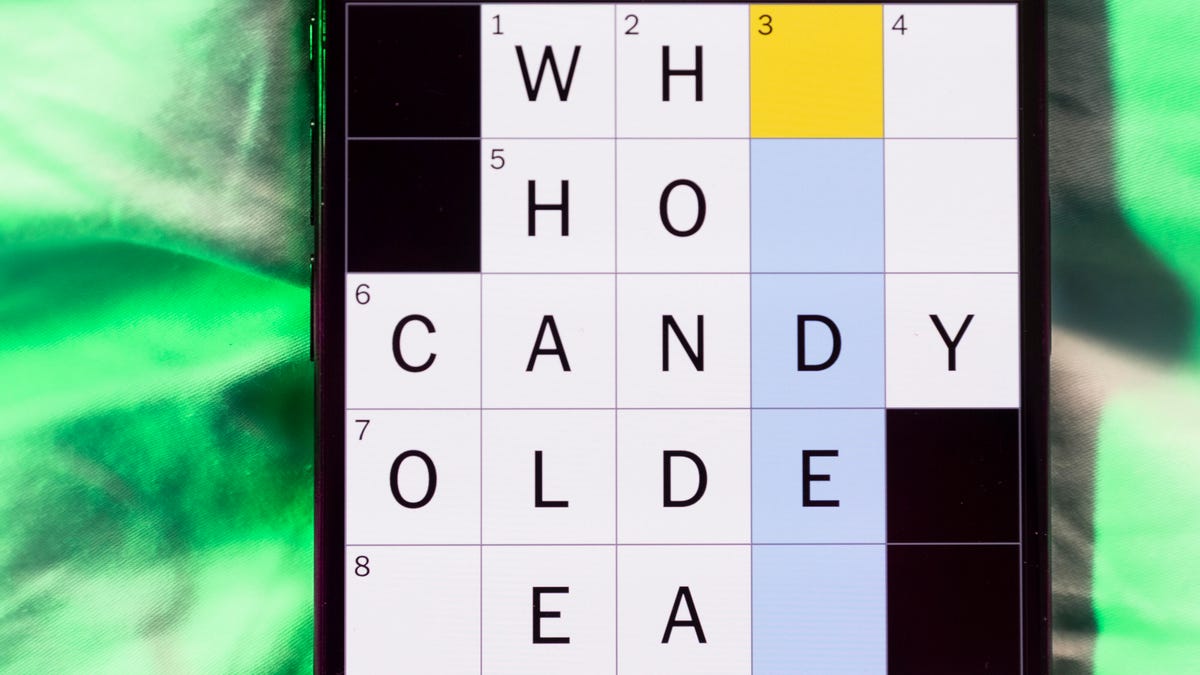
Looking for the most recent Mini Crossword answer? Click here for today’s Mini Crossword hints, as well as our daily answers and hints for The New York Times Wordle, Strands, Connections and Connections: Sports Edition puzzles.
Need some help with today’s Mini Crossword? Read on for the answers. And if you could use some hints and guidance for daily solving, check out our Mini Crossword tips.
If you’re looking for today’s Wordle, Connections, Connections: Sports Edition and Strands answers, you can visit CNET’s NYT puzzle hints page.
Read more: Tips and Tricks for Solving The New York Times Mini Crossword
Let’s get to those Mini Crossword clues and answers.
Mini across clues and answers
1A clue: Tree that’s a symbol of Canada
Answer: MAPLE
6A clue: Back street
Answer: ALLEY
7A clue: Kind of steak with a letter in its name
Answer: TBONE
8A clue: Beer pong targets
Answer: CUPS
9A clue: «___ Pinafore» (Gilbert and Sullivan opera)
Answer: HMS
Mini down clues and answers
1D clue: Show mutual interest, as on a dating app
Answer: MATCH
2D clue: «Bad» or «Good Kid, M.A.A.D City»
Answer: ALBUM
3D clue: Sits (down) heavily
Answer: PLOPS
4D clue: Contact ___
Answer: LENS
5D clue: Look here!
Answer: EYE
Don’t miss any of our unbiased tech content and lab-based reviews. Add CNET as a preferred Google source.
Technologies
Today’s NYT Connections: Sports Edition Hints and Answers for Dec. 1, #434
Here are hints and the answers for the NYT Connections: Sports Edition puzzle for Dec. 1, No. 434.
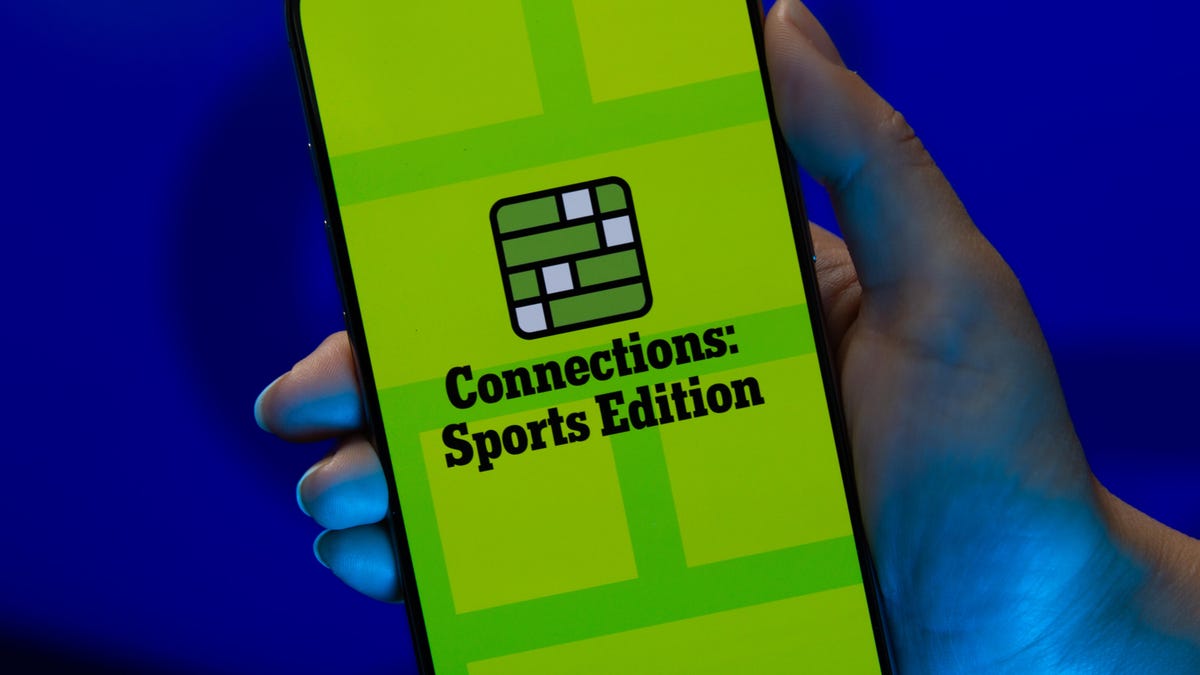
Looking for the most recent regular Connections answers? Click here for today’s Connections hints, as well as our daily answers and hints for The New York Times Mini Crossword, Wordle and Strands puzzles.
Today’s Connections: Sports Edition features one of those classic — and difficult — purple categories. You’ll need to look for words inside of words to get that grouping. (Or just solve the other three, and get purple by default.) If you’re struggling with today’s puzzle but still want to solve it, read on for hints and the answers.
Connections: Sports Edition is published by The Athletic, the subscription-based sports journalism site owned by The Times. It doesn’t appear in the NYT Games app, but it does in The Athletic’s own app. Or you can play it for free online.
Read more: NYT Connections: Sports Edition Puzzle Comes Out of Beta
Hints for today’s Connections: Sports Edition groups
Here are four hints for the groupings in today’s Connections: Sports Edition puzzle, ranked from the easiest yellow group to the tough (and sometimes bizarre) purple group.
Yellow group hint: Maybe on the beach.
Green group hint: Deal me in.
Blue group hint: Not necessarily Jim.
Purple group hint: Look at the final part of the words.
Answers for today’s Connections: Sports Edition groups
Yellow group: Volleyball terms.
Green group: Poker terms.
Blue group: Jameses.
Purple group: Ends in an NWSL team.
Read more: Wordle Cheat Sheet: Here Are the Most Popular Letters Used in English Words
What are today’s Connections: Sports Edition answers?
The yellow words in today’s Connections
The theme is volleyball terms. The four answers are dig, serve, set and spike.
The green words in today’s Connections
The theme is poker terms. The four answers are blind, flop, river and turn.
The blue words in today’s Connections
The theme is Jameses.The four answers are Cook, Harden, Shields and Worthy.
The purple words in today’s Connections
The theme is ends in an NWSL team.The four answers are balderdash (Houston Dash), concurrent (Kansas City Current), foreign (Seattle Reign) and microwave (San Diego Wave).
Don’t miss any of our unbiased tech content and lab-based reviews. Add CNET as a preferred Google source.
Technologies
Today’s Wordle Hints, Answer and Help for Dec. 1, #1626
Here are hints and the answer for today’s Wordle for Dec. 1, No. 1,626.
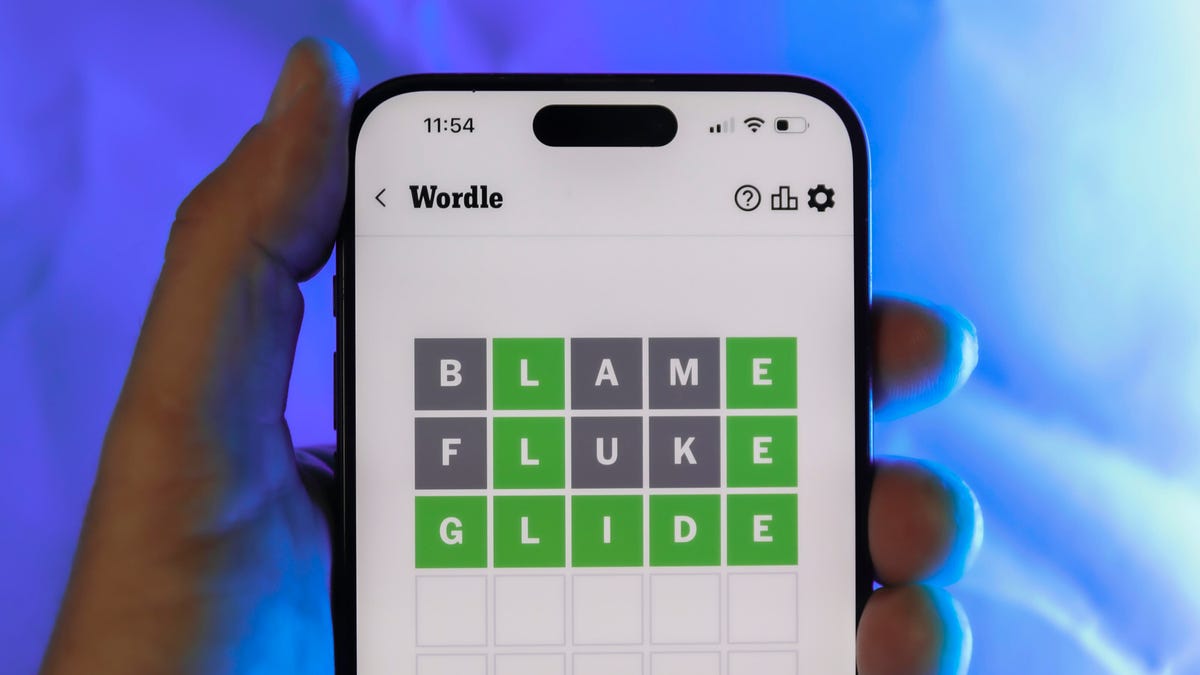
Looking for the most recent Wordle answer? Click here for today’s Wordle hints, as well as our daily answers and hints for The New York Times Mini Crossword, Connections, Connections: Sports Edition and Strands puzzles.
Today’s Wordle puzzle is a little tricky. Many people will confuse it with a similar word that’s spelled differently. If you need a new starter word, check out our list of which letters show up the most in English words. If you need hints and the answer, read on.
Today’s Wordle hints
Before we show you today’s Wordle answer, we’ll give you some hints. If you don’t want a spoiler, look away now.
Wordle hint No. 1: Repeats
Today’s Wordle answer has no repeated letters.
Wordle hint No. 2: Vowels
Today’s Wordle answer has two vowels.
Wordle hint No. 3: First letter
Today’s Wordle answer begins with L.
Wordle hint No. 4: Last letter
Today’s Wordle answer ends with H.
Wordle hint No. 5: Meaning
Today’s Wordle answer can refer to causing a liquid to drain away from something such as soil or ash.
TODAY’S WORDLE ANSWER
Today’s Wordle answer is LEACH.
Yesterday’s Wordle answer
Yesterday’s Wordle answer, Nov. 30, No. 1625 was MUGGY.
Recent Wordle answers
Nov. 26, No. 1621: HOVEL
Nov. 27, No. 1622: REMIT
Nov. 28, No. 1623: COLIC
Nov. 29, No, 1624: GRUFF
Don’t miss any of our unbiased tech content and lab-based reviews. Add CNET as a preferred Google source.
-

 Technologies3 года ago
Technologies3 года agoTech Companies Need to Be Held Accountable for Security, Experts Say
-

 Technologies3 года ago
Technologies3 года agoBest Handheld Game Console in 2023
-

 Technologies3 года ago
Technologies3 года agoTighten Up Your VR Game With the Best Head Straps for Quest 2
-

 Technologies4 года ago
Technologies4 года agoBlack Friday 2021: The best deals on TVs, headphones, kitchenware, and more
-

 Technologies4 года ago
Technologies4 года agoVerum, Wickr and Threema: next generation secured messengers
-

 Technologies4 года ago
Technologies4 года agoGoogle to require vaccinations as Silicon Valley rethinks return-to-office policies
-

 Technologies4 года ago
Technologies4 года agoOlivia Harlan Dekker for Verum Messenger
-

 Technologies4 года ago
Technologies4 года agoiPhone 13 event: How to watch Apple’s big announcement tomorrow
